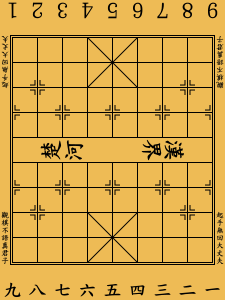
A | B | C | D | E | F | G | H | CH | I | J | K | L | M | N | O | P | Q | R | S | T | U | V | W | X | Y | Z | 0 | 1 | 2 | 3 | 4 | 5 | 6 | 7 | 8 | 9
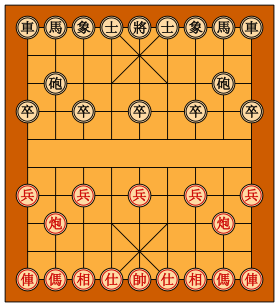 Xiangqi board and starting setup | |
| Years active | Southern Song dynasty to present |
|---|---|
| Genres | |
| Players | 2 |
| Setup time | < 1 minute |
| Playing time |
|
| Chance | None |
| Skills | Strategy, tactics |
| Synonyms |
|
| Xiangqi | |||||||||||||||||||||||||||||
|---|---|---|---|---|---|---|---|---|---|---|---|---|---|---|---|---|---|---|---|---|---|---|---|---|---|---|---|---|---|
| Chinese name | |||||||||||||||||||||||||||||
| Chinese | 象棋 | ||||||||||||||||||||||||||||
| Literal meaning | Elephant chess | ||||||||||||||||||||||||||||
| |||||||||||||||||||||||||||||
| Vietnamese name | |||||||||||||||||||||||||||||
| Vietnamese | cờ tướng | ||||||||||||||||||||||||||||
| Hán-Nôm | 碁將 | ||||||||||||||||||||||||||||
| Literal meaning | General Chess | ||||||||||||||||||||||||||||
| Korean name | |||||||||||||||||||||||||||||
| Hangul | 샹치 | ||||||||||||||||||||||||||||
| Hanja | 象棋 | ||||||||||||||||||||||||||||
| Literal meaning | Elephant Chess | ||||||||||||||||||||||||||||
| |||||||||||||||||||||||||||||
| Japanese name | |||||||||||||||||||||||||||||
| Kanji | 象棋 | ||||||||||||||||||||||||||||
| Hiragana | しょうぎ | ||||||||||||||||||||||||||||
| Katakana | シャンチー | ||||||||||||||||||||||||||||
| |||||||||||||||||||||||||||||
Xiangqi (Chinese: 象棋; pinyin: xiàngqí; Wade–Giles: Hsiang ch'i; English: /ˈʃɑːŋtʃi/), commonly known as Chinese chess or elephant chess, is a strategy board game for two players. It is the most popular board game in China. Xiangqi is in the same family of games as shogi, janggi, Western chess, chaturanga, and Indian chess. Besides China and areas with significant ethnic Chinese communities, this game is also a popular pastime in Vietnam, where it is known as cờ tướng, literally 'General's chess'.
The game represents a battle between two armies, with the primary object being to checkmate the enemy's general (king). Distinctive features of xiangqi include the cannon (pao), which must jump to capture; a rule prohibiting the generals from facing each other directly; areas on the board called the river and palace, which restrict the movement of some pieces but enhance that of others; and the placement of the pieces on the intersections of the board lines, rather than within the squares.
Board

Xiangqi is played on a board nine lines wide and ten lines long. As in the game Go (圍碁; or Wéi qí 圍棋), the pieces are placed on the intersections, which are known as points. The vertical lines are known as files (Chinese: 路; pinyin: lù; "road"), and the horizontal lines are known as ranks (Chinese: 線/綫; pinyin: xiàn; "line").
Centred at the first to third and eighth to tenth ranks of the board are two zones, each three points by three points, demarcated by two diagonal lines connecting opposite corners and intersecting at the centre point. Each of these areas is known as 宮 , a palace.
Dividing the two opposing sides, between the fifth and sixth ranks, is 河 hé, the "river". The river is usually marked with the phrases 楚河 , meaning "River of the Chu", and 漢界 , meaning "Border of the Han", a reference to the Chu–Han War. Although the river (or Hanchu boundary) provides a visual division between the two sides, only two pieces are affected by its presence: soldiers have an enhanced move after crossing the river, and elephants cannot cross it. The starting points of the soldiers and cannons are usually, but not always, marked with small crosses.
Rules
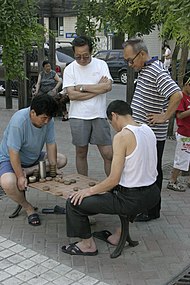
The pieces start in the position shown in the diagram above. Which player moves first has varied throughout history and from one part of China to another. Different xiangqi books advise either that the black or red side moves first.[citation needed] Some books refer to the two sides as north and south; which direction corresponds to which colour also varies from source to source. Generally, Red moves first in most modern tournaments.[1]
Each player in turn moves one piece from the point it occupies, to another point. Pieces are generally not permitted to move through points occupied by other pieces, the exception being the cannon’s capturing move. A piece can be moved onto a point occupied by an enemy piece, in which case the enemy piece is captured and removed from the board. A player cannot capture one of their own pieces. Pieces are never promoted (converted into other pieces), although the soldier gains the ability to move sideways after it crosses the river. Almost all pieces capture using their normal moves, while the cannon has a special capture move described below.
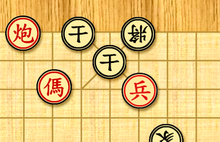
The game ends when one player checkmates the other's general. When the general is in danger of being captured by the enemy player on their next move, the enemy player has "delivered a check" (照將/將軍, abbreviated as 將 ), and the general is "in check". A check should be announced. If the general's player can make no move to prevent the general's capture, the situation is called "checkmate" (將死). Unlike in chess, in which stalemate is a draw, in xiangqi, it is a loss for the stalemated player.
In xiangqi, a player—often with a material or positional disadvantage—may attempt to check or chase pieces in a way such that the moves fall in a cycle, preventing the opponent from winning. While this is accepted in Western chess, in xiangqi, the following special rules are used to make it harder to draw the game by endless checking or chasing, regardless of whether the positions of the pieces are repeated or not:
- A player making perpetual checks with one piece or several pieces can be ruled to have lost unless he or she stops such checking.
- A player who perpetually chases any one unprotected piece with one or more pieces, excluding generals and soldiers, will be ruled to have lost unless he or she stops such chasing.[2]
- If one side perpetually checks and the other side perpetually chases, the checking side has to stop or be ruled to have lost.
- When neither side violates the rules and both persist in not making an alternate move, the game can be ruled as a draw.
- When both sides violate the same rule at the same time and both persist in not making an alternate move, the game can be ruled as a draw.
Different sets of rules set different limits on what is considered perpetual. For example, club xiangqi rules allow a player to check or chase six consecutive times using one piece, twelve times using two pieces, and eighteen times using three pieces before considering the action perpetual.[2]
The above rules to prevent perpetual checking and chasing, while popular, are not the only ones; there are numerous end game situations.[3]
Pieces
Each player controls an army of 16 pieces; the armies are usually coloured red and black.[4] Pieces are flat circular disks labelled or engraved with a Chinese character identifying the piece type, and in a colour indicating which player has ownership. The black pieces are marked with somewhat different characters from the corresponding red pieces.
On mainland China, most sets still use traditional Chinese characters (as opposed to simplified Chinese characters). Modern pieces are usually plastic, though some sets are wooden, and more expensive sets may use jade. In more ancient times, many sets were simple unpainted woodcarvings; thus, to distinguish between pieces of the two sides, most corresponding pieces used characters that were similar but varied slightly.[4] This practice may have originated in situations where there was only one material available to make the pieces from and no colouring material available to distinguish the opposing armies. The oldest xiangqi piece found to date is a 俥 (chariot) piece. It is kept in the Three Gorges Museum.[5][6]
General


Generals (or kings) are labelled 將 (trad.) / 将 (simp.) ("general") on the black side and 帥 (trad.) / 帅 (simp.) ("marshal") on the red side.
The general starts the game at the midpoint of the back edge, within the palace. The general may move and capture one point orthogonally and may not leave the palace, with the following exception.
If the two generals face each other along the same file with no intervening pieces, the 飛將 ("flying general") move may be executed, in which the general to move crosses the board to capture the enemy general. In practice, this rule means that creating this situation in the first place means moving into check, and is therefore not allowed.[7][8]
The Indian name king for this piece was changed to general because of Chinese naming taboos; China's rulers objected to their royal titles being given to game pieces.[9][dubious – discuss] Despite this, the general is sometimes called the "king" by English-speaking players, due to their similar functions as royal pieces.[10]
Advisor

Advisors (also known as guards and less commonly as assistants, mandarins, ministers or warriors) are labelled 士 ("scholar", "gentleman", "officer", "guardian") for Black and 仕 ("scholar", "official", "guardian") for Red. Rarely, sets use the character 士 for both colours.
The advisors start on either side of the general. They move and capture one point diagonally and may not leave the palace, which confines them to five points on the board.[8] The advisor is probably derived from the mantri in chaturanga, like the queen in Western chess.
There is some controversy about whether "士" really is intended to mean "scholar", "gentleman" which would be "士人", or "guard", "guardian" which would be "衛士" (simplified Chinese: 卫士). One argument for the latter is that their functionality seems to be to guard/protect the general. The common Western translation "advisor" does not reflect this layer of meaning.
Elephant

Elephants (or bishops) are labeled 象 xiàng ("elephant") for Black and 相 xiàng ("minister") for Red. They are located next to the advisors. These pieces move and capture exactly two points diagonally and may not jump over intervening pieces; the move is described as being like the character 田 Tián ("field"), in reference to the board's squares.[8] If an elephant cannot move due to a diagonally adjacent piece, it is known as "blocking the elephant's eye" (塞象眼).[11]
Elephants may not cross the river to attack the enemy general, and serve as defensive pieces. Because an elephant's movement is restricted to just seven board positions, it can be easily trapped or threatened. The two elephants are often used to defend each other.
The Chinese characters for "minister" and "elephant" are homophones in Mandarin () and both have alternative meanings as "appearance" or "image". However, in English, both are referred to as elephants, and less commonly as "bishops", due to their similar movements.[10]
Horse

Horses (or knights) are labelled 馬 for Black and 傌 mǎ for Red in sets marked with Traditional Chinese characters and 马 mǎ for both Black and Red in sets marked with Simplified Chinese characters. Some sets use 馬 for both colours. Horses begin the game next to the elephants, on their outside flanks. A horse moves and captures one point orthogonally and then one point diagonally away from its former position, a move which is traditionally described as being like the character 日 Rì.[8] The horse does not jump as the knight does in Western chess, and can be blocked by a piece of either colour located one point horizontally or vertically adjacent to it. Blocking a horse is called "hobbling the horse's leg" (蹩馬腿). The diagram on the right illustrates the horse's movement.
Since horses can be blocked, it is possible for one player's horse to have an asymmetric attack advantage if an opponent's horse is blocked, as seen in the diagram on the right.
The horse is sometimes called the "knight" by English-speaking players, due to their similar movements.[10]
Chariot

Chariots (or rooks or cars) are labelled 車 for Black and 俥 for Red in sets marked with Traditional Chinese characters and 车 for both Black and Red in sets marked with Simplified Chinese characters. Some traditional sets use 車 for both colours. In the context of xiangqi, all of these characters are pronounced as (instead of the common pronunciation chē). The chariot moves and captures any distance orthogonally, but may not jump over intervening pieces. The chariots begin the game on the points at the corners of the board. The chariot is often considered to be the strongest piece in the game due to its freedom of movement and lack of restrictions.[8]
The chariot is sometimes called the "rook" by English-speaking players, since it moves identically to the rook in Western chess.[10] Chinese players (and others) often call this piece a car, since that is one modern meaning of the character 車.
Cannon

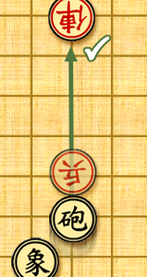
Cannons are labelled 砲 ("catapult") for Black and 炮 pào ("cannon") for Red. The names are homophones, though sometimes 炮 is used for both Red and Black. The 石 shí radical of 砲 means "stone", and the 火 huǒ radical of 炮 means "fire". Both colours' pieces are normally referred to as cannons in English. The black piece is sometimes labelled 包 bāo.
Each player has two cannons, which start on the row behind the soldiers, two points in front of the horses. Cannons move like chariots, any distance orthogonally without jumping, but can only capture by jumping a single piece of either colour along the path of attack. The piece over which the cannon jumps is called the 炮臺 (trad.) / 炮台 (simp.) pào tái ("cannon platform" or "screen"). Any number of unoccupied spaces, including none, may exist between the cannon, screen, and the piece to be captured. Cannons can be exchanged for horses immediately from their starting positions.[8]
Soldier

Soldiers (or pawns) are labelled 卒 ("pawn" or "private") for Black and 兵 ("soldier") for Red. Each side starts with five soldiers. Soldiers begin the game located on every other point one row back from the edge of the river. They move and capture by advancing one point. Once they have crossed the river, they may also move and capture one point horizontally. Soldiers cannot move backward, and therefore cannot retreat; after advancing to the last rank of the board, however, a soldier may still move sideways at the enemy's edge.[8] The soldier is sometimes called the "pawn" by English-speaking players, due to the pieces' similar movements.[10]
Approximate relative values of the pieces
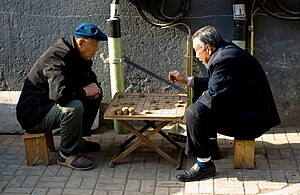
| Piece | Points |
|---|---|
| Soldier before crossing the river | 1 |
| Soldier after crossing the river | 2 |
| Advisor | 2 |
| Elephant | 2 |
| Horse | 4 |
| Cannon | 4½ |
| Chariot | 9 |
These approximate values[12] do not take into account the position of the piece in question (except the soldier in a general sense), the positions of other pieces on the board, or the number of pieces remaining. In what follows, “minor piece” will refer to horses and cannons, and "defensive piece", unless otherwise specified, will refer to the non-royal pieces that cannot cross the river, namely advisors and elephants.
Other common rules of assessment:
- A horse plus a cannon is generally better than two horses or two cannons.
- The chariot is not only the strongest piece, but it is also generally stronger than any combination of two minor pieces. When the relative values of both sides' pieces are approximately even, the side with more chariots generally has the advantage, especially when one side has a chariot and one side does not (Chinese: 有車壓無車). However, the chariot is not particularly strong in basic endgames: for example, chariot versus four defensive pieces is generally a draw, while if the offensive side instead has two horses or even three unadvanced soldiers it is a win.
- In the earlier stages, the cannon is stronger than the horse, because platforms are plentiful and the horse is often blocked by the multitude of pieces on the board. In the endgame, the horse is stronger as an attacking piece, not needing any platforms, but the cannon generally has better defensive abilities.
- The values of soldiers vary in different stages of the game. In the opening and the middlegame, the initiative and mobility of pieces often require sacrificing soldiers. In these stages, soldiers closer to the middle file are generally more valuable, since they can effectively join the offence. With few attacking pieces on the board, soldiers have more power and can cross the river more easily. In this stage, advanced soldiers are generally less powerful, since soldiers cannot move backward. In basic endgames, three soldiers starting on the 7th rank are approximately equal to a chariot: they can force a win against four defensive pieces or a horse/cannon plus two elephants, while instead a chariot cannot, and a chariot cannot force a win against three soldiers on the 7th rank when well-defended.
Notation
There are several types of notation used to record xiangqi games. In each case the moves are numbered and written with the same general pattern.
- (first move) (first response)
- (second move) (second response)
- ...
It is clearer but not required to write each move pair on a separate line.
System 1
The book The Chess of China describes a move notation method in which the ranks of the board are numbered 1 to 10 from closest to farthest away, followed by a digit 1 to 9 for files from right to left.[13] Both values are relative to the moving player. Moves are then indicated as follows:
piece name (former rankformer file)-new ranknew file
Thus, the most common opening in the game would be written as:
- 炮 (32)–35 馬 (18)–37
System 2
| Name | Abbr. | Pieces |
|---|---|---|
| Advisor | A | |
| Cannon | C | |
| Chariot | R* | |
| Elephant | E | |
| General | G | |
| Horse | H | |
| Soldier | S | |
| * using C would conflict with the letter for Cannon | ||
A notation system partially described in A Manual of Chinese Chess[14] and used by several computer software implementations describes moves in relative terms as follows:
single-letter piece abbreviationformer fileoperator indicating direction of movementnew file, or in the case of purely vertical movement, number of ranks traversed
The file numbers are counted from each player's right to each player's left.
In case there are two identical pieces in one file, symbols + (front) and – (rear) are used instead of former file number. Direction of movement is indicated via an operator symbol. A plus sign is used to indicate forward movement. A minus sign is used to indicate backward movement. A dot or period or equals sign is used to indicate horizontal or lateral movement. For a piece that moves diagonally (such as the horse or elephant), the plus or minus sign is used rather than the period.
Thus, the most common opening in the game would be written as:
- C2.5 H8+7
According to World Xiangqi Federation (WXF), in the case of tripled, quadrupled, or quintupled soldiers (pawns), there is no need to specify the P for pawn. Instead, the soldiers are numbered starting from the frontmost soldier, and this number replaces the usual piece abbreviation. The file number is given immediately after as usual.
Thus the notation to move the middle of a set of tripled soldiers on the 5th file to the 4th file would be:
- 25=4
In older books written in Chinese the system is the same, except that: the names of the pieces are written in Chinese; the name for the cannon on both sides is 炮; the name for the horse on both sides is 馬; forward motion is indicated with 進 (pronounced jìn); backward motion is indicated with 退 (tuì); sideways motion is indicated with 平 (píng); and numbers are written in Chinese either for both players or for just Black.
Thus, the most common opening in the game might be written as:
- 炮二平五 馬8進7
System 3
This system is unofficial and principally used by Western players.[citation needed] It is similar to algebraic notation for Western chess. Letters are used for files and numbers for ranks. File "a" is on Red's left and rank "1" is nearest to Red. A point's designation does not depend on which player moves; for both sides "a1" is the lowest left point from Red's side.
single-letter piece abbreviationformer positioncapture indicationnew positioncheck indicationanalysis
Pieces are abbreviated as in notation system 2, except that no letter is used for the soldier.
Former position is only indicated if necessary to distinguish between two identical pieces that could have made the move. If they share the same file, indicate which rank moves; if they share the same rank, indicate which file moves. If they share neither rank nor file, then the file is indicated.
Capture is indicated by "x". No symbol is used to indicate a non-capturing move.
Check is indicated by "+", double check by "++", triple check by "+++", and quadruple check by "++++". Checkmate is indicated by "#".
For analysis purposes, bad moves are indicated by "?" and good moves by "!". These can be combined if the analysis is uncertain ("!?" might be either but is probably good; "?!" is probably bad) or repeated for emphasis ("??" is a disaster).
Thus, the most common opening in the game would be written as:
- Che3 Hg8
For example, the following game is tied with several others as the shortest possible xiangqi game:
|
|
|
Gameplay
Because of the size of the board and the low number of long-range pieces, there is a tendency for the battle to focus on a particular area of the board.[clarification needed]
Tactics
Xiangqi involves several tactics common to games in the chess family. Some common ones are briefly discussed here.
- In a fork, one piece attacks two or more enemy pieces at once.
- A piece is pinned when it cannot move without exposing a more important piece to capture. Every piece except soldiers and advisors can pin, but only chariot pins exactly resemble pins in western chess; pins by other pieces in xiangqi take on many unique forms: Cannons can pin two pieces at once on one file or rank, horses can pin because they can be blocked, and generals can pin because of the "flying general" move rule. In pins by horses and elephants, the pinning piece never attacks the pinned piece, while in a pin by a cannon, only one of the pieces is directly attacked by the cannon. A general can only pin pieces to the enemy general, and the pinning general can never capture the pinned piece, since that would place it in check from the enemy general.
- A piece is skewered when it is attacked and, by moving, exposes a less important piece to be captured. In contrast to pins, only cannons and chariots can skewer.
| Fork | Pin | Skewer |
|---|---|---|
|
Red's horse (傌) at d5 forks black's soldier (卒) at c7 and cannon (砲) at e7.
|
Black's cannon (砲) at e8 is pinned by red's chariot (俥) at e5.
|
Red's chariot (俥) at e5 is skewering black's general (將) at e8 and chariot (車) at e10. When the general moves sideways to avoid being captured, its chariot could be captured.
|
- A discovered check occurs when an attacking piece moves so that it unblocks a line for a chariot, cannon, and/or horse to check the enemy general.
- A double check occurs when two pieces simultaneously threaten the enemy general. Unlike a Western chess double check, a double check in xiangqi may be blockable or, in one case, possibly met with a capture by a piece other than the general. The only blockable cases are either a chariot and cannon on the same file as the general, with the chariot acting as a screen for the cannon, two horses giving discovered check after another piece unblocks the attack from both, or a cannon using an enemy piece as a platform uncovered by a horse (see below). Double checks delivered by other means are not blockable. In one exceptional case, if a horse moves to give a double check by uncovering a cannon, and the cannon’s platform is an enemy chariot or defensive piece (advisor or elephant), the enemy chariot or defensive piece might be able to capture the horse, which removes the cannon’s platform at the same time. Otherwise, capturing either checking piece is insufficient to remove the threat, unless the general makes the capture.
| Blockable double check | Double check met by capture | Double check that compels the general to move |
|---|---|---|
|
Red's horse has moved to d7, creating a double check against Black's general, but Black can answer by moving the cannon to d8, blocking the horse and removing the cannon's platform
|
Red's horse has moved from e4 to d6, unveiling a double check with the cannon, but Black can reply by simply capturing the horse with the chariot.
|
Red's horse has moved from e6 to f8 and placed the black general in double check. Since, as in western chess, there are two independent lines of attack, Black cannot respond with any move other than moving the general to f10, whereupon Red wins Black's horse for free.
|
- Unique to xiangqi is a triple check, which arises in four combinations. In the first case of a cannon, a chariot or soldier, and a horse, the horse moves to give check, uncovering a double check from the chariot and the cannon. In the second, rarer case of a chariot or soldier and two horses, the chariot moves to give check, uncovering a double check from the two horses. In the third case of two cannons and two horses, one cannon may uncover a double check from the horses and act as a screen for the other cannon. Finally, a chariot or soldier can move to give check, uncovering a check from a horse while acting as a platform for a cannon to give another check. Quadruple check is also possible, arising with two horses, a chariot, and a cannon. Triple and quadruple check cannot be blocked or met by captures (again, unless the general makes the capture).
| Triple check | Quadruple check | Triple check, alternate position |
|---|---|---|
|
Red's horse (傌) has moved from e5 to d7, giving check and exposing a double check from the chariot (俥) at e3 and the cannon (炮) at e2.
|
Red's chariot (俥) has moved from f9 to e9, giving check and exposing a triple check from the cannon (炮) at e7 and both horses (傌) at f8 and g9. Replacing the chariot with a cannon or removing a horse produces a triple check.
|
Red's chariot (俥) has moved from f9 to e9, discovering two checks from both horses (傌) at f8 and g9 and gives check itself.
|
In contrast to the ubiquity of pawn chains in western chess, soldiers typically do not support each other until the endgame, because from the initial position it takes a minimum of five moves of a soldier to allow mutual protection between two of them, and they are often prone to capture by other pieces.
Soldiers, horses, cannons and chariots can form up formations that protect each other. However, lining up chariots must be done with caution, as this risks losing one chariot to an enemy's inferior piece. Horses that support each other are called Linked Horses (Chinese: 連環馬), which is a relatively safe formation of the horses, though it can still be threatened with a soldier, a chariot plus another minor piece, or a piece blocking one of the horses thus making the protection one-sided.
It is common to use cannons independently to control particular ranks and files. Using a cannon to control the middle file is often considered vital strategy, because it pins pieces such as the advisors and elephants to the general, which in turn restrict their general’s movement. The two files adjacent to the middle file are also considered important and horses and chariots can be used to push for checkmate there.
Since the general is usually safest in its original position before the endgame phase, attacking the general commonly involves forcing the general out of its original position with check or with threats. Thus, specific points and formations are very important in xiangqi.
For an attacking (Red) horse, the most fatal points are c9 and g9 (Chinese: 臥槽馬), especially since without proper defence a quick mate can follow with an extra chariot or cannon.
| Liang vs. Zhao, 1982
Due to the pin of two pieces by the red cannon, Black's centroid horse has become a liability rather than an asset.
|
For a cannon, one of the most fatal formations is the exposed cannon (Chinese: 空心炮), where the cannon directly controls the middle file with no other pieces between the cannon and the general. This formation is particularly dangerous since the defensive side cannot move any piece in front of the cannon; while with an extra cannon joining the attack, mate can follow on the spot, and with an extra rook, the offensive side can mount a double check (with the rook in front of the cannon) followed by a windmill (as when the check is blocked, the rook moving laterally discovers a new check from the cannon), often winning at least a piece afterwards. If the defensive side cannot chase the cannon away or capture it, it must move the general forward to avoid these threats, leaving the general vulnerable to attacks.
Another fatal formation, called the "cannon-controlled centroid horse" (Chinese: 炮鎮窩心馬, diagram at right), also requires particularly bad coordination of the enemy pieces. In the diagram, Black's "centroid horse" occupies the centre of the palace, blocking Black's own general and advisors, and being pinned to the general by the red cannon, cannot move. Black's cannon at e8 is also pinned to its own general; it too is unable to move and restricts the movement of Black's two elephants, making them unable to protect each other. Such a formation in the middlegame often produces deadly threats of smothered mates, while in the endgame, as in the diagram, Red's cannon cannot be chased away, rendering Black's general, advisors, cannon on e8, and horse all permanently immobilized. Even though Black is up a minor piece, Red has a clear win: The game concluded 41.Hg7 (forking the elephant and pinned cannon and creating a mating threat) Eg10 42.Hh9 Ci9 43.Hf8+ Cf9 (if not for the other black cannon, it is instant mate) 44.Hxg6, and Black resigned: Black's only active piece (the cannon on f9) is absolutely helpless to stop Red's horse and soldiers, which will soon invade the palace.
A common defensive configuration is to leave the general at its starting position, deploy one advisor and one elephant on the two points directly in front of the general, and to leave the other advisor and elephant in their starting positions, to the side of the general. In this setup, the advisor and elephant pairs support each other, and the general is immune from attacks by cannons. Losing any defensive pieces makes the general vulnerable to cannon attack, and the setup may need to be abandoned. The defender may move defensive pieces away from the general, or even sacrifice them intentionally, to ward off attack by a cannon.
|
Red mates in 11 Solution: 1.Rh10++
1. ...Af10 2.Rh9+ Afe9 3.Rg10++ Af10 4.Rg9+ Afe9 5.Rh10++ Zdroj:https://en.wikipedia.org?pojem=Elephant_chessText je dostupný za podmienok Creative Commons Attribution/Share-Alike License 3.0 Unported; prípadne za ďalších podmienok. Podrobnejšie informácie nájdete na stránke Podmienky použitia.
Analytika
Antropológia Aplikované vedy Bibliometria Dejiny vedy Encyklopédie Filozofia vedy Forenzné vedy Humanitné vedy Knižničná veda Kryogenika Kryptológia Kulturológia Literárna veda Medzidisciplinárne oblasti Metódy kvantitatívnej analýzy Metavedy Metodika Text je dostupný za podmienok Creative
Commons Attribution/Share-Alike License 3.0 Unported; prípadne za ďalších
podmienok. www.astronomia.sk | www.biologia.sk | www.botanika.sk | www.dejiny.sk | www.economy.sk | www.elektrotechnika.sk | www.estetika.sk | www.farmakologia.sk | www.filozofia.sk | Fyzika | www.futurologia.sk | www.genetika.sk | www.chemia.sk | www.lingvistika.sk | www.politologia.sk | www.psychologia.sk | www.sexuologia.sk | www.sociologia.sk | www.veda.sk I www.zoologia.sk |



